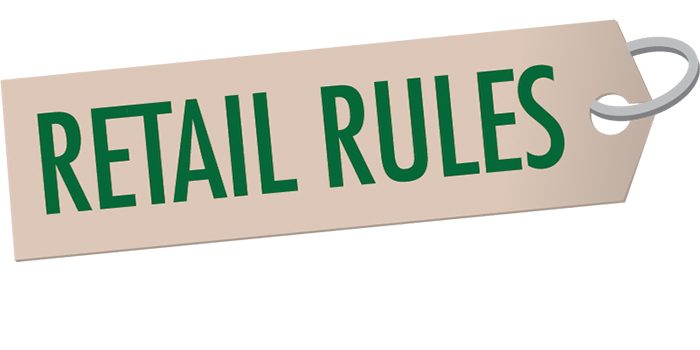Many dealers struggle with how to provide a professional retail experience for their customers. It can be difficult to know exactly what your showroom is missing or you may be concerned about the effort and investment necessary to make the necessary updates.
Jennifer Robison, of Robison Retail Results, says that with a little time and effort you can elevate your retail space and improve the customer experience. Rural Lifestyle Dealer recently talked with Robison about the topic of visual merchandising. She uses her almost 30-year experience in the retail industry to share how small changes can bring in big profits. (Go here to listen to the Rural Lifestyle Dealer Podcast discussion.)
Rural Lifestyle Dealer: Why do you believe it’s so important for dealerships to have a clean, attractive and a purchase-friendly space?
Jennifer Robison: When I say the space has to be clean or clutter free or neat, I mean that it just has to be shoppable. It has to be organized in a way that makes sense. It has to be where you can sense the product. Visual merchandising is not about how white your walls are or what floor color you chose. It is about seeing the product, making it accessible, and inspiring the customer to buy it.
There are two types of buying that happens in the retail zone — the purchasing you do because you discover a product and the purchase you make when you ask for something you need. These are two different buying experiences and if people aren’t attracted to the other products you’re selling, you’re missing out on sales.
RLD: What misconceptions do dealers have about how their retail space should look?
Robison: Nobody’s doing anything wrong. They know what they know or they’re copying something that they know. However, some dealers, whether it’s in powersports, marine, or even in the green stores, model themselves after a retailer that isn’t in their same retail segment. That may not work because the color choices, fixtures or lighting don’t help you earn more sales.
Generally, I tell dealers that it doesn’t matter the size of your store or your budget. However, if the store is dark or if the products are not accessible, that’s where we run into problems. So I try not to impose any rules about their showroom, but if it doesn’t feel right to you, it doesn’t feel right to your customers either.

RLD: How do you start the process of evaluating a retail environment?
Robison: When I enter, I can immediately sense the space. That’s one of the things that I have internally. I don’t think owners and managers understand how the space occurs to the shopper. For example, is it too big, too loud, too dark, too cluttered, or too fancy?
For instance, if a store is too fancy, then customers may perceive it as being too expensive. It’s about the balance in your retail space and it’s all about the product. Customers have the best experience when they’re able to buy more than they expected to buy when they arrived.
Here’s what I do with my clients when we’re looking at the store. The very first step is to start in your parking lot. Simply drive into your dealership and instead of going in the back door or the side door where you might normally go, go through the front door.
Park like a customer would and look around. What’s the condition of the building’s exterior? Many retailers keep up their exterior spaces, but there are many who don’t. For instance, they haven’t replaced any mulch or trimmed plants and bushes. They haven’t recently striped the parking lot or maybe fingerprints or outdated promotional materials cover the front door.
Those kinds of details send the first message to the customer. Again, customers know when something isn’t quite right, but they’re never going to verbalize it. No customer is ever going to come and say, “Hey, I really like you, but your store doesn’t look so good, it just doesn’t feel right to me or it’s too dark or have you ever thought about cleaning it up?”
You also have to recognize that you have first-time customers and your regular customers. Your “regulars” know who you are and will put up with certain things because you have good service. However, you could probably sell more if your store was more put together.
After we evaluate the exterior, we go in the front door and start the evaluation again. Are the rugs old or dirty? Are there dead plants in the window? Have the displays been updated or rotated recently? Are displays faded or dusty? These are some areas to fix that are not very costly.
RLD: What do you look for while inside the store?
Robison: It’s important to change regularly your product displays and even the layout. Don’t get married to the same layout year after year after year. That tends to happen because sales managers and owners like the layout.
In some cases, you may not be able to change certain layouts because of where doors are located or how you move equipment in and out. However, if the showroom looks the same year after year, even though it’s neat and tidy, people can get bored with it and they forget to shop other parts of the store.
We really want people to navigate more of the store. This can be difficult with a male shopper, who tend to be very straightforward about what they need. On the other hand, women shoppers tend to scan the entire store. We have to do our best to encourage male shoppers to get off the main path and visit other parts of the store.
RLD: How can dealers encourage customers to notice more of their stores?
Robison: Product placement, fixture placement, brand placement are important elements. Also, keep in mind seasonal displays and how you change out your end cap displays. My background is in the powersports industry and those dealers are changing out displays about every 3 months.
Think about add-on sales for toys, clothing or other merchandise. Some times of the year you may want to move those items to the front of the store. You just have to keep it flowing and keep it interesting. There is a lot happening in powersports and many brands are really battling for space in the stores. So, you are seeing different solutions to customize the space.
Powersports stores sell a lot of apparel. That merchandise has to move constantly because the shelf life on any apparel product is very short. The only product that have a longer shelf life might be things like safety apparel.
RLD: What have you heard in terms of some of the arguments against fixing up a retail space?
Robison: There are plenty of them and they are mostly excuses because owners and managers don’t want to make changes. For instance, they might bring up expense as an excuse, but the costs of some changes are minimal, like cleaning the carpets or freshening up a store with new paint. Stores need to be painted every 8 to 10 years. Sometimes, it’s a matter of just cleaning fixtures or removing promotional fixtures for brands you no longer carry.
In the powersports industry, there is a fair amount of dealers that get married to inventory that’s 12, 24, 36 or even 48 months old. You do not want that in your showroom.
Again, it’s all about perception. Probably the easiest and most important thing to do is update your lighting. Customers hate dark stores and dark spaces in stores. Look for areas that are dim because you have task-type lights, not feature lights.
There is no excuse not to update with the new LED lights — that’s my biggest advice. LED lights offer a brighter, wider and cleaner light and you’ll virtually never have to replace them. They also don’t run as hot as incandescent lights, so they help keep a store cooler in the summer.
RLD: What other best practices or best tips in product display that you can share with us?
Robison: I’m not a fan of the word “best practices” because everything has a variable to it and I hate giving rules. If you give a rule to a dealer, they will stick with it for life. Later, that rule may be not as applicable because something else has changed in the dealership.
So, let me just start by saying there are no rules, there are guidelines. For instance, if it’s dirty, you need to clean it. If it’s old, you need to eliminate it. If it’s too dark, you need to find a way to brighten it up or rearrange the fixtures so it’s not a dark space. Sometimes the arrangement of your displays or fixtures causes darkness or a dead zone. So, open it up! Give yourself at least 4 feet between every fixture so people have space.
Height rules — there are some experts who say your employees must be able to see over fixtures so they don’t overlook customers. However, if you have three people at a parts counter and they’re knee-deep in helping customers, it doesn’t matter how tall your fixtures are, their heads are down. They’re in that computer or in that book or on that phone, and they’re not looking out over the store anyway.
So, if you have good displays that are a little taller, don’t be afraid to use them. I’m not saying you should ever totally block your sight lines, just be realistic about adhering to certain rules.
Evaluate your older fixtures to make sure they work with any new products you’re carrying. If they don’t’, work with your manufacturer or supplier to come up with something new.
Keep things moving forward! Customers like to see progress, so be willing to make changes or bring in something new. Customers will notice when you are not bringing in anything new. They won’t mention it to you, but they may spend less money or go to another dealership.
RLD: What kind of guidelines can you share about inventory?
Robison: The minimum is two turns a year on a product. Every dealership is different and I understand that. If you’re a small store and you have a small budget, then you want to stock things that have high turnover, like tools, parts or accessories that sell more quickly. Go a little deeper with your quantities, a little wider with it, and you’ll probably do well.
There is one time a year when you want to stock up heavily with novelty items and that’s just before your busy season starts or at the holidays. I know that sometimes you don’t have a choice because the OEMs require you to carry a certain amount of inventory.
Space is money, so do you feel like all the products taking up space in your store make sense today?
RLD: It can be difficult, especially with specialty items, to know what customers wants. What advice can you give dealers regarding that?
Robison: Some retailers engage with customers and seek their feedback and others wait for the next person to walk in the door.
Also, many owners or managers are making purchasing decisions based on what they like and you can’t do that. You have to think about how quickly it will sell and how relevant it is to what you already sell. Find out if there are any competitors that could “steal your thunder” on new products and find out the buying requirements? It’s really about what the customer will buy, not necessarily what I like.
RLD: Is there anything we haven’t talked about that dealers should know?
Robison: Dealers just need to know that visual merchandising is a strategy. Do you know that 70% of buying decisions are actually made in the store?
I know that the internet is a big player today. It has its place, but so does the store. You always have to remember that your job is to influence your buyer every time they come in the door. Maybe you have a new product or an expansion of a product brand. Or, maybe it’s some new feature Whatever it is, show something new, one thing every month at least. And, remember to keep your store clean and get rid of outdated signs, promotional materials and products. No one wants to buy products that look used.
Do you have a question related to your retail showroom? Email us and we'll pass it along to Jennifer Robison and address in an upcoming Retail Rules post.






Post a comment
Report Abusive Comment